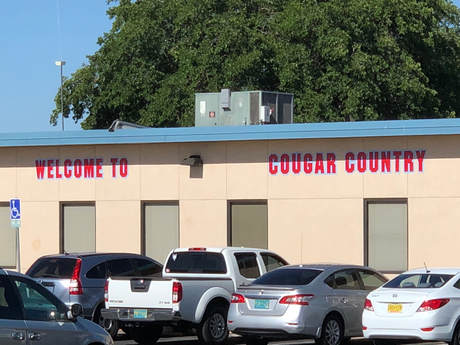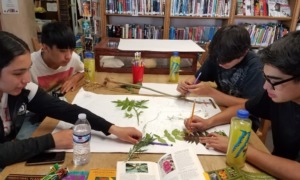
Lynn Community Middle School in Las Cruces, N.M., offers support services for families, school-aged children, the elderly people and older teens.
Before Kasandra A. Gandara first became a member of the Las Cruces City Council, she was in the trenches as a case worker and regional manager for the Children, Youth and Families Department (CYFD) in Doña Ana County. Gov. Michelle Lujan Grisham, following her 2018 election, asked Gandara to be a part of a transition team that gave incoming CYFD cabinet secretary Brian Blalock intel on what’s really needed to effectively reform foster care and child welfare in New Mexico.
Her feedback was valued due to the foster care and child well-being reforms she and local child welfare advocates accomplished for Doña Ana County’s at-risk kids, Gandara said. The Las Cruces Public School’s rising graduation rates, by far the highest in the state, is a direct result of Doña Ana County’s impact models, which started to become a reality back in 2008, she said.
Additionally, a 2017 community school pilot program has been a success for vulnerable citizens of Las Cruces; the city will soon expand the concept to a second location. Meanwhile, area youth who end up in state care may benefit from locally trained social workers at New Mexico State University. An NMSU professor says the next crop of social workers are looking to apply their newfound knowledge in Doña Ana County and along the U.S.-Mexico border.
The Doña Ana County branch of CYFD started soul-searching in 2008 and eventually hired consultants, who told them that “consistency was the number one thing,” Gandara said. “When your workers are leaving and the families have to deal with yet another new worker, it takes too long to bring the worker up to speed and for the family to trust the new worker. Our clients already had a mistrust of the system and of us.”
As a result, they created The Piñon Project, which focused on placing children with trusted relatives instead of in traditional foster care settings. CYFD Secretary Blalock says that increasing the state’s kinship care numbers is one of CYFD’s highest priorities.
“State agencies don’t make good parents. It has been proven over and over in all of this research,” Gandara said. “There’s a lot of trauma for kids that are placed in foster care and stay in foster care and don’t have a permanent placement. They’re not safe and secure as they move through the system and are raised into adulthood.”
City Focused on Foster Kids
The city has also been a leader in improving high school graduation rates. The 86.2% graduation rate at Las Cruces Public Schools in 2018 topped both the statewide average of 73.9% and the national average of 84.6%. Despite the improvements, Gandara says she and city leaders aren’t celebrating because “some who aren’t graduating are foster kids. I think every kid coming into care needs to have an educational plan from age 0 to 3, and not just one case manager but wraparound services.”
Gandara, who’s in the middle of her second term as District One Councilor, says foster youth can soon find solace at Booker T. Washington Elementary School. In July, the city received an appropriation of approximately $100,000 to create a second community school there, where many different types of populations can receive support services. Lynn Middle School became Las Cruces’ first community school in 2017.
“It’s a one-stop shop, and not just for families and school-aged children but also elderly people or older teens that don’t have resources or supportive services,” Gandara said. “They come to the schools and get [General Educational Development degrees] or [English as a Second Language] courses or job training.” The city is looking to expand the community school model to Doña Ana Elementary and potentially MacArthur Elementary, she said.
Gandara also helped establish a regional Heart Gallery, a photography exhibition inside the Las Cruces City Hall lobby that shows children statewide who are available to be adopted.
[Related: CYFD Forging Ahead With Native American Court, Kinship Care]
[Related: Carlsbad Center Partnering With Eddy County CASA to Serve More Young People]
[Related: McKinley County Could Benefit From New Court For Tribes]
[Related: Native American Court to Run Under Bigger Concept of Family]
“We try to provide our foster parents with supportive services, all while trying to manage the kiddos’ trauma and all of the necessary appointments that they’re required to go to,” Gandara said. “We have to encourage and teach and provide an array of services to ensure that parents are getting those skills in a system that’s already strained.”
Over at the main campus of NMSU, the School of Social Work is educating a dedicated group of students who may not be planning to take their skills to another state. Approximately 42,000 more people left the state than entered New Mexico between 2011 and 2016, according to Census Bureau data. Overall, the exodus of a college-educated workforce has been attributed to the state’s shortage of attractive, well-paying jobs and poor chances of advancement for young, talented professionals.
“We have students who come here who are interested in doing work on the border and students who realized that New Mexico is 50th in the country for child well-being,” said Jeffrey McCabe, a School of Social Work assistant professor. The program offers bachelor’s and master’s curricula in traditional classroom settings as well as online degrees.
“Students aren’t coming here to get their degree and looking to leave immediately,” he said. “If anything, social work at NMSU has grown because we offer completely online degree programs.”
This story is part of a Youth Today project on foster care in New Mexico. It’s made possible in part by the May and Stanley Smith Charitable Trust. Youth Today is solely responsible for the content and maintains editorial independence.





























